Ata-ul-Haye Nasir, Ahmadiyya Archive & Research Centre
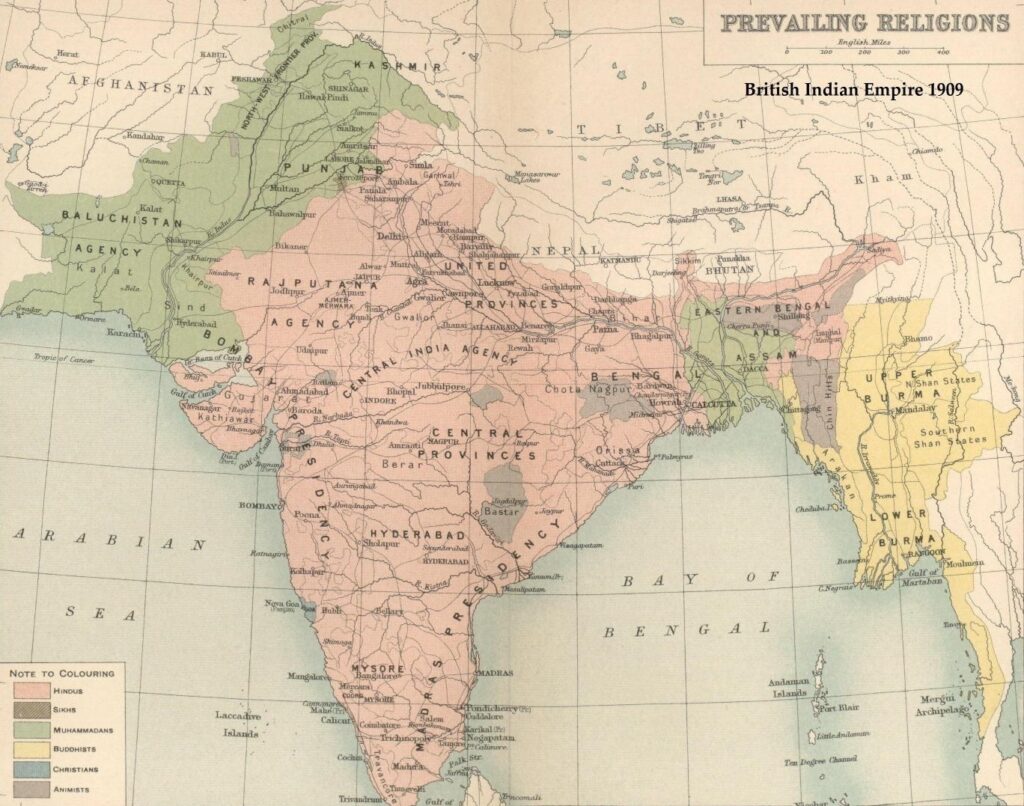
In the late 1870s and early 1880s, the Arya Samajists were running a malicious campaign against Islam in which they were objecting to the teachings of the Holy Quran, mocking the miracles mentioned therein, and attempting to malign the blessed character of the Holy Prophet Muhammadsa.
At that juncture, Hazrat Mirza Ghulam Ahmadas of Qadian undertook to defend the miracles mentioned in the Holy Quran, particularly the splitting of the moon, and to prove its magnificence. Thus, he penned Surma-e-Chashm-e-Arya.
Announcement by Riaz-i-Hind
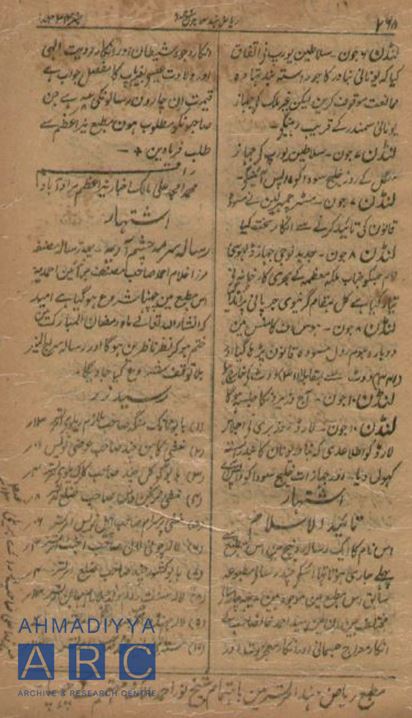
This book was published from the Riaz-i-Hind Press in Amritsar. While it was being printed, the newspaper Riaz-i-Hind of Amritsar announced:
“Risala Surma-e-Chashm-e-Arya: The printing of this magazine, written by Mirza Ghulam Ahmad Sahib — author of Barahin-e-Ahmadiyya — has commenced in this press. It is hoped that it will be completed by the holy month of Ramadan and available for the public to read, and the Risala Siraj-ul-Munir will be printed without any delay.” (Riaz-i-Hind, 14 June 1886, Vol. 1, No. 34, p. 268)
The same announcement was published on 21 June 1886 as well.
What’s in the book?
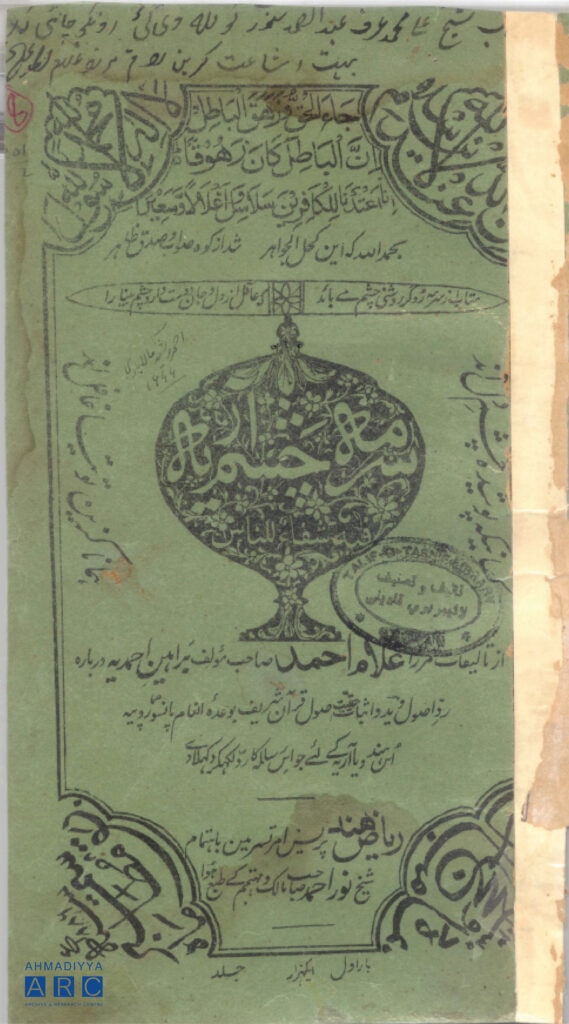
This book carries the details of a debate between Hazrat Ahmadas and Lala Murli Dhar, Drawing Master (an Arya Samajist), which took place on 11 to 14 March 1886. At the end of the book, Huzooras invited the whole of the Arya Samaj to a comparative study of the Vedas and the Holy Quran and then suggested another way of settling the dispute by engaging in a Mubahalah (Prayer Duel). Hazrat Ahmadas extended an invitation to the non-Muslims to come to Qadian so that he might show them heavenly signs in favour of Islam and he offered to bear all the expenses for anyone who was prepared to come to Qadian and stay for at least 40 days.
Reaction: Praise and opposition
In the beginning, the Muslim clerics would praise Hazrat Ahmad’sas services for Islam and consider him a great defender of the Islamic faith. When he wrote Surma-e-Chashm-e-Arya in 1886, not only the Muslim clerics, but even the Christian press too commended his work, for instance, Nur-i-Afshan of Ludhiana wrote a review on 6 January 1887 and Maulvi Muhammad Hussain Batalwi published a review in his magazine Ishaat-us-Sunnah (Vol. 9, Number 5, pp. 145-158). Their details shall be presented later in this article.
In his book, while defending the teachings of the Holy Quran and proving the validity of the miracles mentioned therein, Hazrat Ahmadas also questioned certain beliefs of the Arya Samaj which they would attribute to their holy scripture, i.e., the Vedas. This turned them furious and they began to attack Islam more vigorously and falsely alleged Hazrat Ahmadas for initiating controversies between Arya Samaj and Islam.
However, the truth is that Hazrat Ahmadas merely defended Islamic teachings in response to the disrespectful attacks by the Arya Samaj, and showed them their own face in light of the beliefs which they proudly professed. These controversies were, in fact, initiated by the Arya Samajists themselves, even before Hazrat Ahmadas wrote Barahin-e-Ahmadiyya.
Hence, before mentioning the details regarding Surma-e-Chashm-e-Arya it is important to briefly state its background and the attacks on Islam from the Arya Samajists and the Christians.
Arya Samaj’s attacks on Islam before Barahin-e-Ahmadiyya
Hazrat Ahmadas published an announcement in May 1879, wherein he told the world about the objective of writing Barahin-e-Ahmadiyya, and said that the reason behind this book was that Pandit Dayanand, the founder of Arya Samaj had disrespected the Holy Prophet Muhammadsa, Mosesas and Jesusas, and declared the Holy Quran and Bible to be untruthful. (Majmu‘ah-e-Ishtiharat [2019], Vol. 1, pp. 19-20)
In this regard, Bob van der Linden – a historian of South Asia and global history – states:
“Although the main targets of Swami Dayanand Saraswati were orthodox Hindu practices and Christianity, he dedicated more space in his Satyarth Prakash to attack Islam than any other tradition. He further contributed to anti-Islamic agitation when he published” his work “Gokarunanidhi (1880), interestingly based on economic rather than spiritual grounds. […]
“In turn, importantly, large portions of Mirza Ghulam Ahmad’s[as] Barahin-i-Ahmadiyah argued systematically against the statements of the Arya Samaj, especially as proclaimed by Dayanand in the Satyarth Prakash. In fact, he even wrote a letter to Saraswati offering him to send a copy of the Barahin-i-Ahmadiyah to debate the truth of Islam and its superiority over Hinduism. Dayanand however did not respond and sometime later Ghulam Ahmad[as] reported a dream (as he regularly did) in which he saw Dayanand dying (as happened soon afterwards). Before that time, nonetheless, Ahmadiyahs already were considered major enemies of Punjabi Aryas, resulting in the fierce polemic relationship between Pandit Lekh Ram and Mirza Ghulam Ahmad[as].” (Tradition, rationality and social consciousness: The Singh Sabha, Arya Samaj and Ahmadiyah – Moral languages from colonial Punjab [2004], University of Amsterdam, p. 165)
Anti-Islam rhetoric from the Christian and Arya clergy in 1880s
In the 1880s, the attacks on Islam from the Christian and Arya clergy were on the rise. The opponents of Islam were unable to refute the arguments presented by Hazrat Ahmadas in Barahin-e-Ahmadiyya to prove the truthfulness and magnificence of Islam. They left no stone unturned in opposing Hazrat Ahmadas in an effort to veil the greatness of Islam proved by this champion of Islam and the servant of the Holy Prophet Muhammadsa.
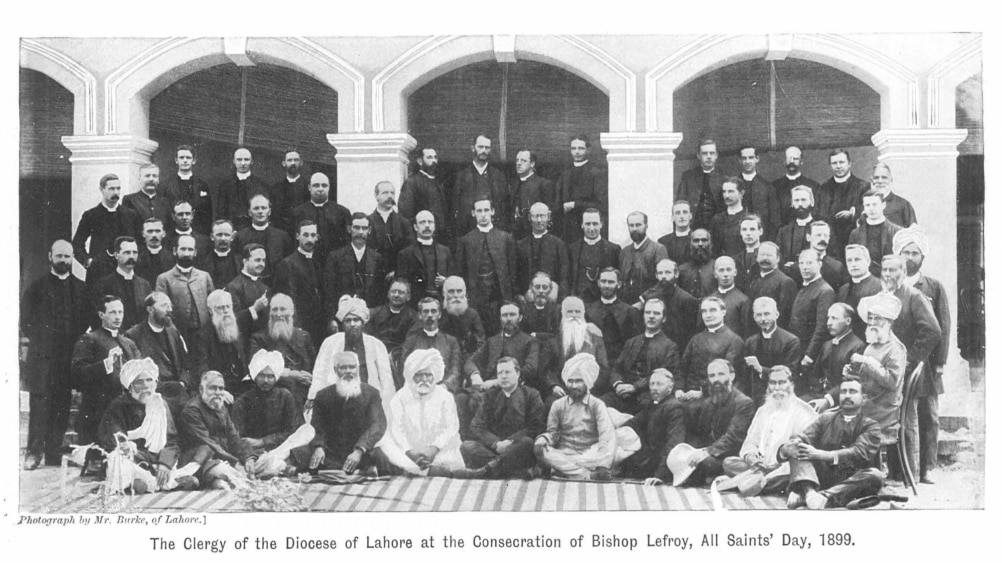
Attacks on the Holy Quran and Holy Prophetsa by Nur-i-Afshan
On 27 May 1880, a series of articles commenced in Nur-i-Afshan of Ludhiana, by Rev. GL Thakur Das, titled “Adam Zuroorat-e-Quran” – The Redundancy of the Quran – in which he asserted that there was no need for the Quranic teachings as the other scriptures, particularly Bible, were enough for mankind’s guidance at all times. He implied that the Quranic teachings were imperfect and not compatible with every era.
Moreover, another series of articles were published by the same newspaper, titled “Wasiyyat-Nama Hazrat Muhammad Sahib” – The Will of Hazrat Muhammad Sahib (referring to the Hadith-e-Qirtas) in which the author asserted that the teaching brought by the Holy Prophetsa was not perfect and wrote on 9 February 1882 that, God forbid, the Holy Prophetsa was doubtful about the Holy Quran being the Word of God and asserted that he did not manifested any sign and miracle in reality. The author mentioned the miracle of the splitting of the moon as well.
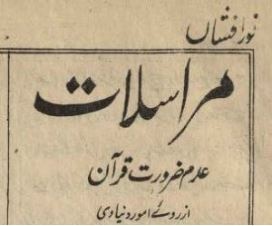
A challenge in 1885
In March 1885, Hazrat Ahmadas gave a challenge and invited people of all religions and walks of life, both in India and the West, to stay at Qadian for a year in order to witness the signs in favour of the truthfulness of Islam. However, no one had the courage to truly accept this challenge, though a few clerics showed interest in the beginning but the later incidents exposed their real intentions.
For more details on this, see “Hazrat Ahmad’s claim to be the Promised Messiah and opposition from the religious clergy and press”, at alhakam.org (19 April 2024).
In Surma-e-Chashm-e-Arya, Hazrat Ahmadas shortened the time period to 40 days, inviting the religious clergy once again, including Lekhram, Athim, Imaduddin, Thakur Das, and Jeevan Das, and wrote that instead of one year, they should stay at Qadian for 40 days to witness a sign in favour of Islam, and in case no such sign is manifested, they would be rewarded 500 rupees. (Surma-e-Chashm-e-Arya, Ruhani Khazain, Vol. 2, pp. 309-310)
Demand for a sign from the Arya Samajists
The assaults on Islam and the noble character of the Holy Prophetsa were in full force. The Christian missionaries were exhausting all efforts to defame Islam and the opposition of the Arya Samaj saw no end.
The Arya Samajists, like Indarman Moradabadi and Lekhram were demanding for a sign to be manifested to prove the truthfulness of Islam, hence, Hazrat Ahmadas supplicated to Allah the Almighty in Hoshiarpur for 40 nights in seclusion, seeking Divine manifestation. (“Forty nights of seclusion”, alhakam.org, 19 February 2021)
Mentioning this demand for a sign, Hazrat Musleh-e-Maudra stated during an address in Lahore on 12 March 1944:
“The Promised Messiahas has written that at that time, allegations were being levelled against Islam that it did not possess any power to show any signs. Hence, Pandit Lekhram was claiming that if Islam was a true faith, then a sign should be shown. Indarman Moradabadi was raising the same objection that if Islam was a true faith, then demonstrate a sign. Thus, the Promised Messiahas prostrated before Allah the Almighty and supplicated: ‘O my Lord! Demonstrate a sign that convinces these people of Islam who seek a sign. Show such a sign which would convince people like Indarman Moradabadi about Islam.’” (“‘God has declared me the Promised Son’: Glimpse into Hazrat Musleh-e-Maud’s speeches of 1944 in Hoshiarpur, Lahore, Ludhiana, and Delhi”, alhakam.org, 16 February 2024)
The Prophecy about the Promised Son
Thereafter, on 20 February 1886, Hazrat Ahmadas published an ishtihar, titled “Risala Siraj-e-Munir Mushtamil bar Nishaan-Haaey Rabb-e-Qadeer”, in which he mentioned a glad tiding which he received from God Almighty about a son. (Majmu‘ah-e-Ishtiharat [2019], Vol. 1, pp. 121-127)
Mentioning this ishtihar, the Sahifa-i-Qudsi of Delhi wrote an article on 4 March 1886, about which the Indian Newspaper Reports stated under the heading “So-called prophecies by one Ghulam Ahmad, Punjab”:
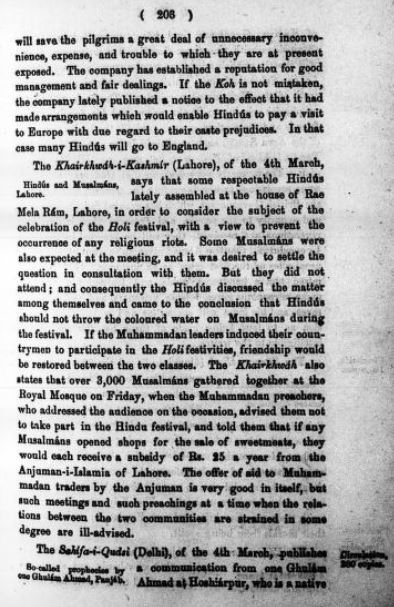
“The Sahifa-i-Qudsi (Delhi), of the 4th March, publishes a communication from one Ghulam Ahmad at Hoshiarpur, who is a native of Kadian, Gurdaspur, and has long carried on religious discussions with the Arya Samaj. The writer says that he will shortly publish a book under the name of Siraj-i-Munir, i.e., the Splendid Lamp, which will convince people of the truth of the Muhammadan religion. The book will contain prophecies relating to (1) the writer and his family, (2) his friends and some other persons, and (3) the leading members of the Arya Samaj, such as Munshi Indarman of Moradabad, Pandit Lekhram of Peshawar, &c., and some Hindus of Kadian. The writer is very desirous that God may also make some revelations to him regarding the triumph over Russia of the British Government, which has granted full liberty, peace, and security to the people, and remarks that if any such revelations are received, they will be inserted in the book. In conclusion, Ghulam Ahmad gives an account of one of the prophecies of the first class as an instance. God has promised him a handsome, noble, and learned son who will make miraculous cures, release prisoners, and make four of three, and his fame will spread far and wide. The revelation as to four being made of three by the son is not intelligible to the writer.” (Selections from the Vernacular Newspapers, 1886, pp. 203-204)
Riaz-e-Hind’s article and its supplement
On 1 March 1886, the Riaz-i-Hind wrote under the heading “Risala Siraj-ul-Munir, Musannafa Mirza Ghulam Ahmad Sahib Raees-e-Qadian”:
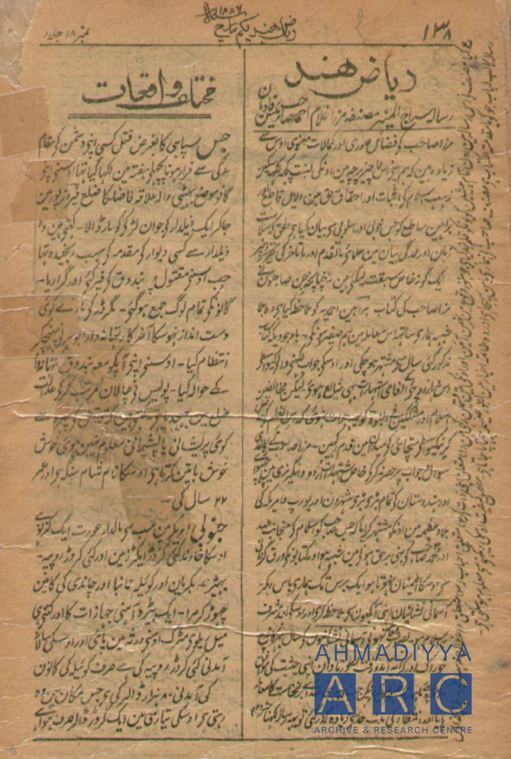
“Mirza Sahib’s evident characteristics and spiritual magnificence are far greater than what we can write here in our humble paper to commend it. The beautiful and apt way in which he has defended the religion of Islam and presented irrefutable arguments and clear proofs in proving the Truth, compells us to say that in terms of simplicity [salasat] and excellence of writing, he has surpassed the writings of the ulema of the past and the coming times. Hence, those who have read Mirza Sahib’s book Barahin-e-Ahmadiyya, would undoubtedly agree with us in this matter. Despite the fact that the said book has been advertised for many years and announcements for a reward of 10,000 rupees were also published for anyone who could respond to it, the opponents of Islam and those who are doubtful about the prophethood [nabuwwah] could not have the courage to step into the field of truthfulness to receive this reward. Mirza Sahib did not merely rely on written questions and answers [i.e., books in response to each other] and published special announcements in Urdu and English and circulated them in all the major cities of India and the major countries of Europe and America, so that anyone who is doubtful about Islam being from God and Muhammad[sa] Sahib being the truthful prophet, and are not satisfied with reading the [arguments presented in various] books, ought to stay with him for one year and witness the heavenly signs from their own eyes and consequently accept Islam. In case of the absence of any heavenly signs, they could receive 200 rupees per month in accordance with their position for the expenditures of the whole year on food and travel fares. However, when he had no response to this, and the waiting period crossed a limit, he began writing this magazine. In the beginning, the author has mentioned all the prophecies which are yet to be fulfilled and has divided them into three categories: (1) In relation to his own self (2) In relation to his friends (3) In relation to the preachers of the other religions. Hence, the gist of this magazine, which is in fact the preface [muqaddamah] of the book, has been sent to us by the author, and it will be published as a supplement at the end of this issue. The complete details could only be known upon reading it fully.” (Riaz-i-Hind, 1 March 1886, p. 138)
Hence, that gist was then reproduced in the supplement of this issue of Riaz-i-Hind.
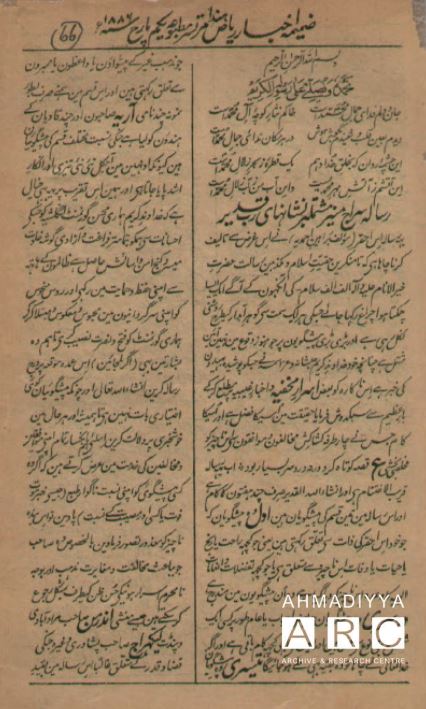
Rev. GL Thakur Das and Barahin-e-Ahmadiyya, 1886-87
In 1886-1887, the Christian newspaper Nur-i-Afshan of Ludhiana published a series of articles by Rev. GL Thakur Das, in which he objected to the arguments presented by Hazrat Ahmadas in defence of Islam in his book Barahin-e-Ahmadiyya. This series consisted of five parts, which concluded on 14 April 1887.
GL Thakur Das was one of the three Christian missionaries who were settled upon to assist Deputy Abdullah Athim during the debate between the Promised Messiahas and Abdullah Athim, published as Jang-e-Muqaddas. (The Holy War [Jang-e-Muqaddas], p. 3)
GL Thakur Das, in his articles, attempted to malign the beautiful teachings of Islam, the majesty of the Holy Quran, and the blessed character of the Holy Prophetsa. The tone of these articles was very harsh and abusive towards Hazrat Ahmadas as well.
The opponents of Ahmadiyyat must ponder here that Hazrat Mirza Ghulam Ahmadas was facing these reactions and vile language in return for his efforts to prove the magnificence of Islam and the blessed character of the Holy Prophet Muhammadsa.
For instance, in the fourth part of this review, the author commenced in the following words:
“Mirza Ghulam Ahmad Sahib proves Muhammad Sahib to be the Best among all other prophets in the following way….” (Nur-i-Afshan, 20 January 1887, p. 4)
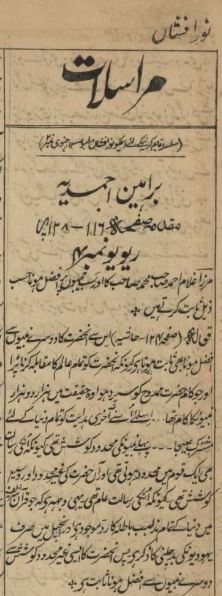
In its 21 April 1887 issue, Nur-i-Afshan wrote, “The review on Barahin-e-Ahmadiyya has now concluded, let’s see what Mirza Sahib responds to it.” (Ibid., 21 April 1887, p. 3)
The author attempted to ‘refute’ the arguments presented by Hazrat Ahmadas in defence of Islam, however, the truth is that Barahin-e-Ahmadiyya comprises unparalleled arguments which cannot be refuted by anyone.
On 2 January 1890, Nur-i-Afshan published a remark by a person named Waiz, about the review on Barahin-e-Ahmadiyya by GL Thakur Das. The author used inappropriate words and wrote:
“The respected missionary dealt with only that part wherein Mirza [Ghulam Ahmadas] has presented arguments on Muhammad[sa] being a truthful prophet. […]
“Those who consider Mirza to be a mujaddid and a messenger, and deem Barahin-e-Ahmadiyya to be the completion of proof on his prophethood, for instance, some unwise individuals from Ludhiana and Batala, ought to kindly read this review as well.” (Nur-i-Afshan, 2 January 1890, p. 5)
Surma-e-Chashm-e-Arya, challenge to Munshi Jeevan Das and Nur-i-Afshan’s review
Hazrat Ahmad’s book Surma-e-Chashm-e-Arya included an ishtihar (announcement), titled “Ishtihar Inaami Paanch So Rupiya” – An announcement for a reward of 500 rupees, in which he wrote:
“This book, meaning the Risala Surma-e-Chashm-e-Arya, has been written – at the occasion of a debate with Lala Murlidhar Sahib Drawing Master of Hoshiarpur, that completely exposes false beliefs of Vedas – with the claim and certainty that no Arya can refute [the arguments presented in] this book because falsehood has no standing in front of the truth. However, if an Arya Sahib considers all the fundamentals and beliefs of the Vedas which have been refuted in this book to be true and still considers the Vedas and such fundamentals to be established by Esher, then in the name of the same Esher, they ought to write a review on this book and get 500 rupees as a reward. These 500 rupees would be rewarded after the approval by an arbitrator, who will be a Christian missionary or a Brahmo Sahib. Moreover, I agree to the extent that once the refutation is written and published publicly, then if Munshi Jeevan Das Sahib, Secretary of the Arya Samaj Lahore – who is a more well-natured, honourable and dignified person among the Arya Sahibs of the surrounding areas – could come to a public gathering of Muslim, Arya and Christian scholars, etc., along with his beloved sons, and swears:
“‘Yes, my heart is certain that all the objections of Risala Surma-e-Chashm-e-Arya, which I have carefully read from the beginning to the end and have carefully understood, have been refuted by this writing. And if I do not say this with heartfelt satisfaction and complete truth, then its harm and disaster may fall on me in this world and on my progeny who is present at this time.’
“After swearing on such a testimony by Munshi Sahib, 500 rupees cash would be rewarded to the refuter in the same gathering. And if Munshi Sahib remained safe from the evil effects of such swearing for a year, then it would undoubtedly be a proof for the Aryas that the said person had sworn with sincerity of heart according to his knowledge and intellect.” (Majmu‘ah-e-Ishtiharat [2019], Vol. 1, pp. 151-152)
A Christian newspaper, Nur-i-Afshan of Ludhiana, published a review on the Promised Messiah’s book Surma-e-Chashm-e-Arya, titled “Risala Surma-e-Chashm-e-Arya” which stated:
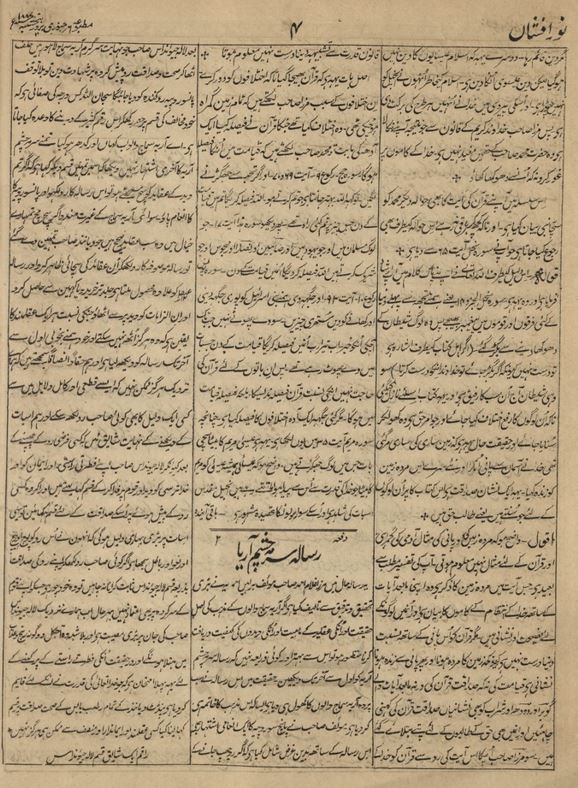
“This magazine has recently been written by Mirza Ghulam Ahmad Sahib[as] — author of Barahin-e-Ahmadiyya — with great research and thoughtfulness. If one desires to acquaint themselves with the true reality and nature of beliefs professed by the Arya Samajists and the reality of their Vedas, there is no better way than to read the magazine Surma-e-Chashm-e-Arya from start to end. This magazine has truly exposed the Arya Samajists, and in such a manner that as if this religion has been effaced. Along with this magazine, the author has also included an announcement for a reward of 500 rupees, with the object that in case a refutation is published and Lala Jeevan Das Sahib — who is very prominent among the Arya Samajists in Lahore [Secretary Arya Samaj Lahore] — testifies on oath to the validity and truthfulness of the given refutation, then without any hesitation, 500 rupees would be awarded to the refuter. SubhanAllah [Holy is Allah], how immense purity is this that a reward of such a huge amount is being promised, relying on the oath of the opponent himself. O Arya Smajists! Where are you now? Did you not read the concluding announcement of Surma-e-Chashm-e-Arya? In that, you have been invited to write a refutation of this magazine if you consider the Arya beliefs to be truthful and get a reward of 500 rupees in return. So, O ye who possess jealousy for the Arya Samaj! If you really believe that all those beliefs are true which have been taught to you by Dayanand Sahib, then you ought to manifest the truthfulness of those beliefs by writing a refutation of the said magazine. You should buy this magazine as soon as possible which is available in 1 rupee and 12 annas, excluding tax, or get it from somewhere else and purify Vedas from these objections which are believed by every sensible person that they cannot be alleviated. We ourselves have read this magazine from start to end and we believe, on merits of justice and truthfulness, that in our view, it is not possible at all for anyone to write a refutation to even a single argument from such perfect and decisive arguments. Moreover, we are really anticipating to witness as to how Jeevan Das Sahib could compromise his natural truthfulness, faith and mercifulness, for the sake of Vedas and his community, by taking an oath. And if he refrains from testifying on oath to the truthfulness of that refutation, then this very fact would be a huge proof that he has considered that refutation to be inferior, invalid and false. If one writes a refutation and does not want to prove its truthfulness through the testimony on oath by Lala Jeevan Das, then it makes that person dishonest, as if they do not even trust the prominent leader of their community. Anyway, in our view, there is a huge burden on the shoulders of Lala Jeevan Das Sahib, and undoubtedly, he would be nowadays subject to exceeding distress and agony, and in reality, this is the first trial to assess his natural truthfulness which has been arranged by the act of God Almighty. Is it possible for any wise, honest and just person to testify on oath to each and every teaching of Pandit Dayanand? Not at all.” (Nur-i-Afshan, 6 January 1887, p. 4)
Review in Ishaat-us-Sunnah
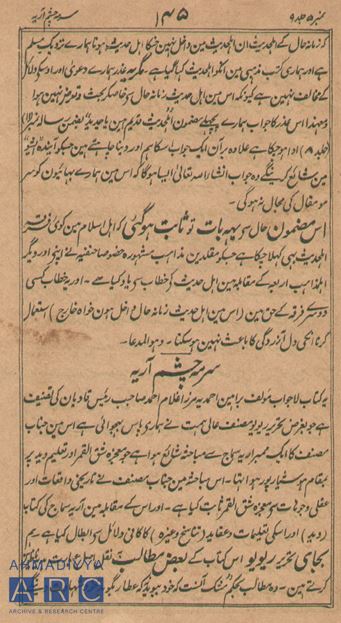
Maulvi Muhammad Hussain of Batala also wrote a review of this book and published it in his magazine Ishaat-us-Sunnah. He wrote under the heading “Surma-e-Chashm-e-Arya”:
“This unmatchable book has been written by the author of Barahin-e-Ahmadiyya, Mirza Ghulam Ahmad Sahib, Chief of Qadian, which has been sent to me by the courageous author for writing a review. This includes a debate between the respected author and a member of the Arya Samaj which took place in Hoshiarpur about the miracle of splitting of the moon and the teachings of Vedas. In this debate, the respected author has proven the miracle of the splitting of the moon through historical incidents and intellectual arguments. On the other hand, he has refuted – through sufficient arguments — the teachings and beliefs of the Book of Arya Samaj, i.e., Veda, for instance reincarnation, etc. I would present to the readers some insights from that book, by presenting the actual text, instead of writing a review.” (Ishaat-us-Sunnah, Vol. 9, Number 5, pp. 145-158)
After this, he reproduced some parts from the Promised Messiah’sas book.
Comment by The Paisa Akhbar
The Paisa Akhbar of Lahore stated:
“It would not have been out of place if the Hindus – especially the Aryas – and the Christians, had stood up vigorously in opposition to Mirza Sahib[as], since all of the efforts of Mirza Sahib[as] are in support of the Muslims and against the [anti-Islam efforts of the] Aryas and Christians, as is evident from his famous works such as Barahin-e-Ahmadiyya, Surma-e-Chashm-e-Arya and later writings.” (“Promised Messiah’s 1892 visit to Lahore: A rising tide of opposition”, alhakam.org, 26 April 2024)
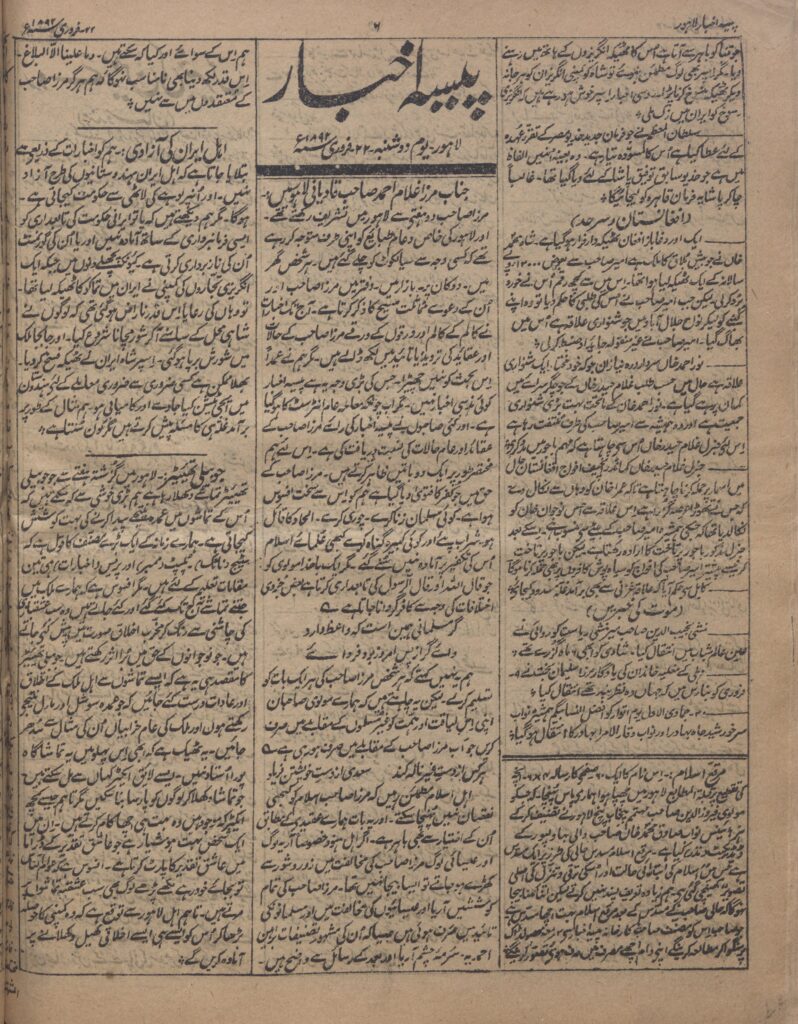
Shahna-e-Haqq
When Surma-e-Chashm-e-Arya was published, the Aryas were stunned and instead of responding to it academically, they brought out a book filled with abuses.
In its 21 April 1887 issue, Nur-i-Afshan wrote that they had received two books written by Arya Samajists, one of them being “Surma-e-Chashm-e-Arya ki haqiqat aur fan fareb Ghulam Ahmad ki kaifiyyat”. In this book, vile and abusive language was used against Hazrat Ahmadas. It was written by some Hindus of Qadian, and published from the Chashma-e-Nur Press Amritsar with the help of Pandit Lekhram. The article by Nur-i-Afshan also contained abusive language.
In response, Hazrat Ahmadas wrote Shahna-e-Haq, and refuted all those objections and false notions which were levelled against him in the above stated book.
Since Pandit Lekhram had also written a book, titled Takzib Barahin-e-Ahmadiyya, in an attempt to refute Barahin-e-Ahmadiyya, Huzooras also dealt with some points raised in Pandit Lekhram’s book.
The Nur-i-Afshan then remarked on Shahna-e-Haqq, in its 26 May 1887 issue, titled “Remark Risala Shahna-e-Haqq par”, and continuing its practice, used inappropriate language and raised false allegations on Hazrat Ahmadas.

As far as the content of Takzib Barahin-e-Ahmadiyya is concerned, it will be appropriate to present an article of The Paisa Akhbar of Lahore, about which the Indian Newspaper Reports stated under the heading “Pandit Lekh Ram’s attack on Islam”:
“The Paisa Akhbar (Lahore), of the 29th August 1896, states that Pandit Lekh Ram, Arya, has written a book called the ‘Takzib-i-Burahin-i-Ahmadya.’ This work, which has been issued from the Chashma-i-Nur Press, Amritsar, is calculated to cause great mischief. The book purports to be a refutation of Mirza Ghulam Ahmad’s ‘Burahin-i-Ahmadya,’ but the Pandit, in utter disregard of the canons of strict criticism, has used the most offensive (lit. heart-rending) and insulting language towards Islam, its leaders, its followers, including the Prophets, and things held sacred by the Muhammadans. After condemning the use of such language, the Editor calls upon the authorities to stop the sale of the book, which has caused great excitement among the Muhammadans, lest matters should assume a serious aspect. It is strange that while the ‘Kulliat-i-Sadi’ has been suppressed at Bombay and the publishers fined, no steps should have been taken to prevent the sale of a work that is calculated to injure the feelings of a large community and to cause a breach of the public peace.” (Selections from the Vernacular Newspapers Published in the Punjab, Vol. 9, No. 37, p. 517)
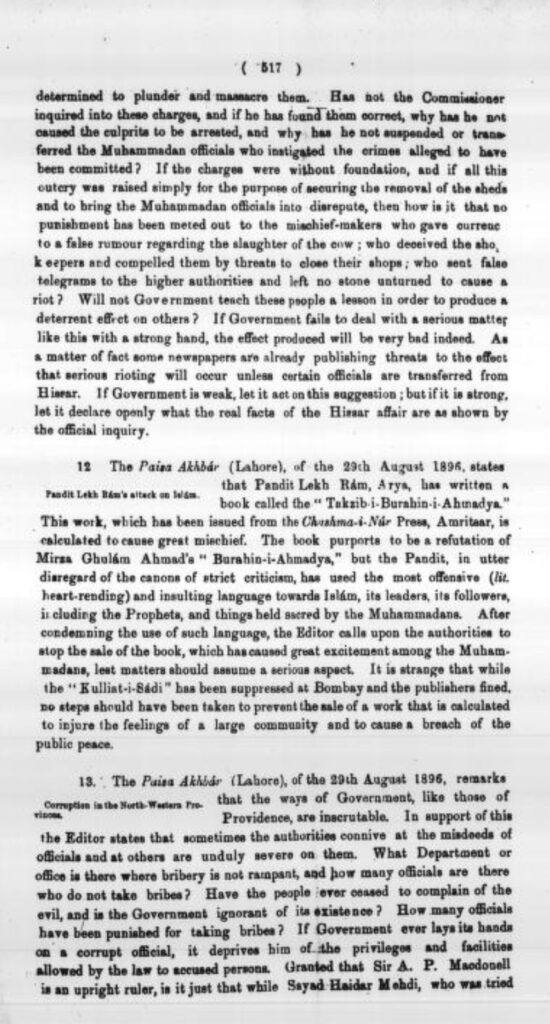
Article by Rev. Thomas Howell Bashir, 1887
On 16 June 1887, an article by Rev. Thomas Howell Bashir of Pind Dadan Khan was published under the heading “Risala Shahna-e-Haqq aur Mirza Ghulam Ahmad Sahib ka Ilhaam”, in which he objected to a revelation of Hazrat Ahmadas and used abusive language.
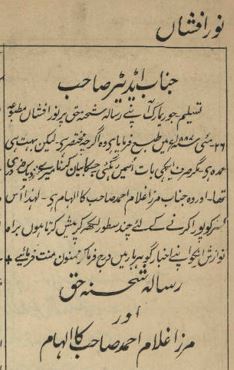
Thomas Howell Bashir was one of the three Christian missionaries who were settled to assist Deputy Abdullah Athim during the between the Promised Messiahas Abdullah Athim, published as Jang-e-Muqaddas. (The Holy War [Jang-e-Muqaddas], p. 3)
“On Whit-Sunday, the Bishop of Lahore held an Ordination at Simla, when Mr. Thomas Howell, a Native Agent of the C.M.S., was admitted to Holy Orders. He will be in-charge of the Jhelum Mission, Pind Dadan Khan, as a “deacon evangelist,” that is, he will not be a pastor of a congregation under the Native Church Council, but be employed directly by the Society as an evangelistic missionary.” (The Church Missionary Gleaner, Vol. 9, 1882, p. 100)
It is important to mention here that the same missionary wrote a review on Hazrat Hakeem Maulvi Noor-ud-Din’sra book Fasal-ul-Khitab li Maqaddama Ahl al-Kitab. Huzoorra wrote this book in obedience to Hazrat Mirza Ghulam Ahmad’sas instruction that he should write a book to refute the false beliefs of the Christians. (Nur-i-Afshan, 31 October 1889, pp. 2-3)
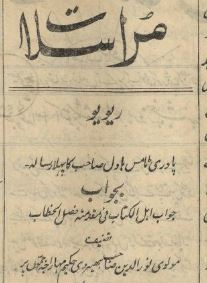
Hazrat Mufti Muhammad Sadiqra states:
“There was a priest named Thomas Howell in Pind Dadan Khan. In response to his questions, Hazrat Khalifatul Masih Ira wrote the book, ‘Fasal-ul-Khitab li Maqaddama Ahl al-Kitab.’ Thomas Howell was later posted to Lahore. When the debate between the Promised Messiahas and Padri Abdullah Athim took place in 1893 and a prophecy was made public about Athim, I wrote a letter to Priest Thomas Howell about that prophecy. In it, I stated that many debates had taken place between Muslims and Christians in the past, but that very debate had a special superiority over the others because there was a prophecy about Athim. I was in Bhera at the time of writing that letter. I also sent a copy of that letter to my honourable teacher, Hazrat Khalifatul Masih Ira who was in Qadian in those days. Hazrat Maulvi Sahibra presented my letter before the Promised Messiahas. The Promised Messiahas commended the subject of that letter and said, ‘Only Allah helps [him] to write [in such a manner].’” (Zikr-e-Habib, p. 9)
Hazrat Ahmadas inaugurated the Eid Gah in Batala, 1888
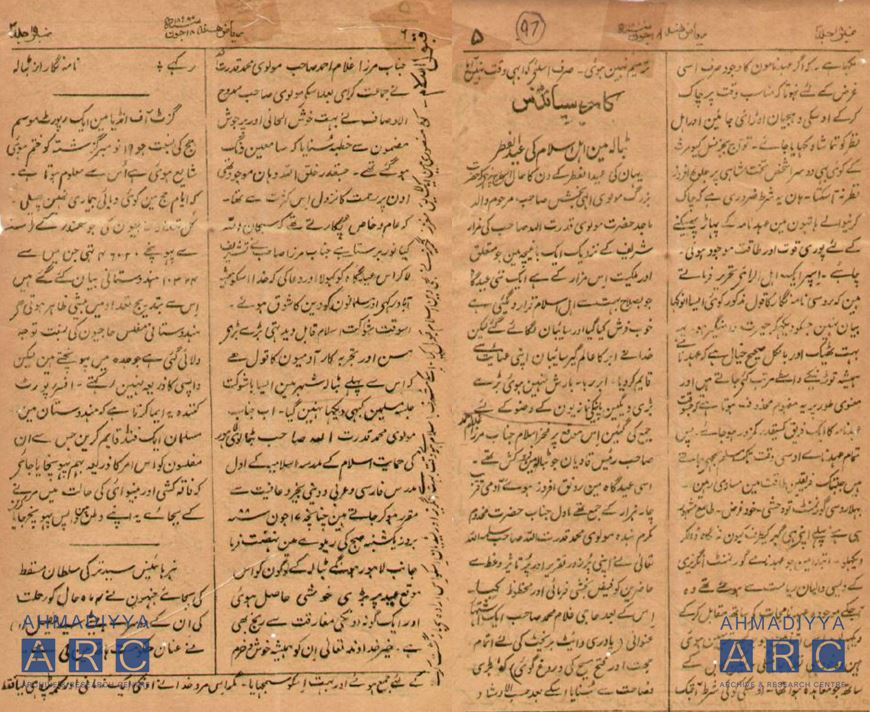
While mentioning the events of the 1880s, it will be interesting to present a news report about Eid-ul-Fitr in Batala that was published in Riaz-i-Hind of Amritsar. The report stated under the heading “Batala mein Ahl-e-Islam ki Eid-ul-Fitr”:
“On this occasion, Fakhr-e-Islam Respected Mirza Ghulam Ahmad Sahib, Chief of Qadian – who was in Batala at the time – graced the same Eid Gah. There were around 4,000 people present. […] Haji Ghulam Muhammad Sahib very eloquently read out an ishtihar [of Hazrat Ahmadas which he issued on 9 June 1888], titled ‘Paadri Weitbrecht ke liay Ittmam-e-Hujjat aur Fateh Masih ki Darogh-goie’. Following this, in accordance with the instruction from respected Mirza Ghulam Ahmad Sahib, Maulvi Muhammad Qudratullah led the congregation [in Eid prayer]. Such a great blessing was being showered upon the people who gathered there in huge number that both the common and prominent of those were stating that ‘SubhanAllah, what a nur [divine light] is descending that respected Mirza Sahib has inaugurated this Eid Gah and prayed that may God always keep it populated and may the Muslims be inclined towards the Faith.’ This occasion was a great scene of the grandeur of Islam. It was acknowledged by many prominent and experienced people that such a majestic Muslim gathering has never been witnessed previously in Batala city.” (Riaz-i-Hind, 18 June 1888, pp. 5-6)
Sabz Ishtihar [The Green Announcement], 1888
On 1 December 1888, Hazrat Ahmadas published an ishtihar on the demise of Bashir Awwal, titled “Haqqani Taqrir bar Wafaat-e-Bashir” – A Discourse upon the Demise of Bashir. Since it was published on a green paper, it is known as the “Sabz Ishtihar”, i.e. The Green Announcement. In this announcement, Huzooras said:
“In my case, however, none of the prophecies that I have made on the basis of revelation have turned out to be wrong. Divine revelation had clearly foretold the birth of two boys, and also that some of my children would die in infancy. See the announcements of 20th February 1886 and 10th July 1888. In accordance with the first prophecy, a child was born and he soon died. The second child, whom the revelation refers to as Bashir the Second, and also as Mahmood, has not been born till today, 1st December 1888. But, in accordance with God’s promise, he will most certainly be born within the time stipulated in the prophecy. Heavens and earth may pass, but the word of God can never be averted. Fools laugh at His revelations and ridicule His holy tidings because the end is hidden from their eyes.” (The Green Announcement [Sabz Ishtihar], p. 8 [footnote])
Thereafter, in accordance with the prophecy made on 20 February 1886 and the later announcements by Hazrat Ahmadas, a son was born on 12 January 1889 who was named Bashir-ud-Din Mahmud Ahmad.
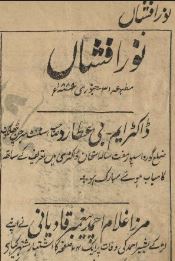
Nur-i-Afshan’s response
In response, Nur-i-Afshan published an article on 31 January 1889 and, continuing its practice, mocked the prophecies and revelations of Hazrat Ahmadas. The article mentioned the birth of Hazrat Sahibzada Mirza Bashir-ud-Din Mahmud Ahmadra and wrote that Hazrat Ahmadas named him Bashir and Mahmud as a tafavul. Addressing Hazrat Ahmadas, it wrote, “Your claim to be a prophet has no proof.” (Nur-i-Afshan, 31 January 1889, p. 1)
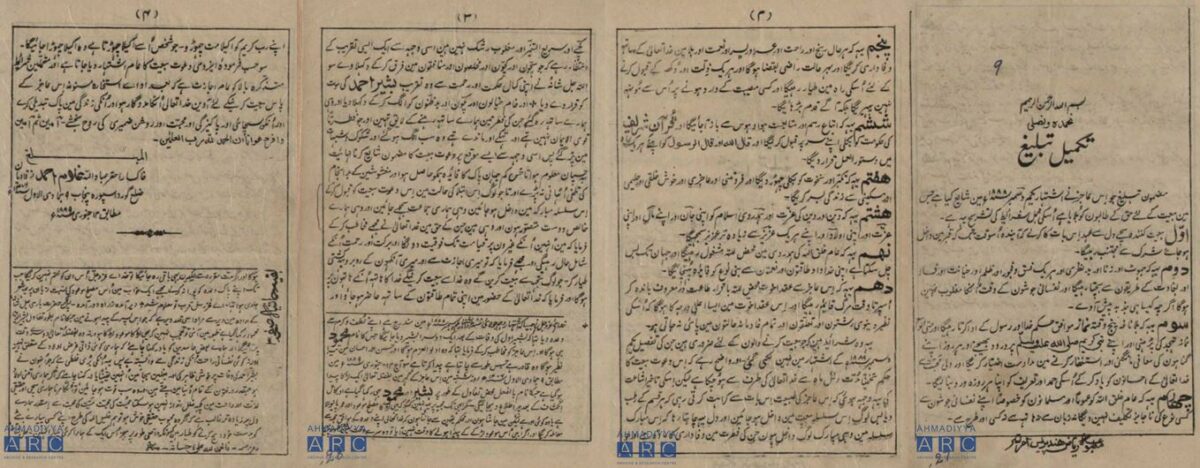
The article also referenced the statement of Hazrat Ahmadas which he announced in an ishtihar dated 12 January 1889, titled “Takmil-e-Tabligh”, where Huzooras mentioned the birth of his son and stated that he was named Bashir and Mahmud, and that it will be announced after being categorically informed from God whether that son is the Promised Son or someone else. Huzooras wrote that it had not yet been revealed to him as to whether this son was the Musleh-e-Maud and the son who was destined to live a long life. Huzooras then mentioned the following Persian couplet which was revealed to him in relation to the Musleh-e-Maud:
اے فخر رسل قرب تو معلومم شد
دیر آمدۂ زِ راہِ دُور آمدہٖ
“O pride of the messengers! I have been made aware of your high rank in the nearness of Allah; You have come after a wait since you have come from a very far place.”
Huzooras continued:
“Hence, if in accordance with the decree of the Exalted and the Sublime God, this ‘wait’ means the amount of wait which has occurred in the birth of this son who has been named Bashir-ud-Din Mahmud as a tafavul, then it should not be a surprise if this very son is the Promised one.” (Majmu‘ah-e-Ishtiharat [2019], Vol. 1, p. 208 [footnote])
The article of Nur-i-Afshan objected that Hazrat Ahmadas refrained from mentioning any revelation in this regard. However, the answer to their objection has been given by Hazrat Ahmadas in his above-mentioned statement, that he had not yet been categorically revealed by God Almighty about this matter, and would announce upon receiving any divine information. And this is the practice of all the Prophets and Appointed Ones of Allah the Almighty.
Once Allah the Almighty revealed to him the insight on this matter, he made an announcement to the world.
An excerpt from Siraj-e-Munir
In his book Siraj-e-Munir, Hazrat Ahmadas has clearly stated:
“The fifth prophecy which I announced was in regard to the birth of my son Mahmud that he will be born and he will be named Mahmud. And this prophecy was published in the form of an announcement on a green paper that is still preserved and was distributed to thousands of people. Therefore, that son was born within the time period of the prophecy [of 1886], and has now entered his ninth year of age.” (Siraj-e-Munir, Ruhani Khazain, Vol. 12, p. 36 [footnote])
Conclusion
Hazrat Mirza Ghulam Ahmadas came to the battlefield of Jihad by Pen and for this reason, the religious clergy and the press were determined to oppose him and left no stone unturned in maligning his blessed character in their effort to veil the magnificence of Islam and the Holy Quran which were highlighted by this great champion of Islam in his writings. The opponents remained unsuccessful in all of their efforts!
The grand prophecy of 20 February 1886 was fulfilled by Allah the Almighty in 1889, which was a great sign as demanded by the opponents of Islam. Hazrat Ahmadas was blessed with the Promised Son — the Musleh-e-Maud — Hazrat Mirza Bashir-ud-Din Mahmud Ahmadra.
In March 1889, when Hazrat Ahmadas established the Ahmadiyya Muslim Jamaat and then claimed to be the Promised Messiah and Mahdi, it was as if the whole world had begun to oppose him; Christian missionaries, Arya Samajists, and even the Muslim clerics. The Muslim clerics turned into his staunch enemies, instead of joining his efforts in the service of Islam. Its details have been narrated in the following articles:
“Hazrat Ahmad’s claim to be the Promised Messiah and opposition from the religious clergy and press” (published on 19 April 2024)
“Promised Messiah’s 1892 visit to Lahore: A rising tide of opposition” (published on 26 April 2024)
This was just the beginning of an era of severe opposition, and the following years saw an unprecedented rise in the opponents’ efforts to halt his mission and to defame him. However, divine help and succour was with him at all times, hence, he continued to succeed in his mission to prove the magnificence of Islam and highlighting the blessed character of the Holy Prophet Muhammadsa.

